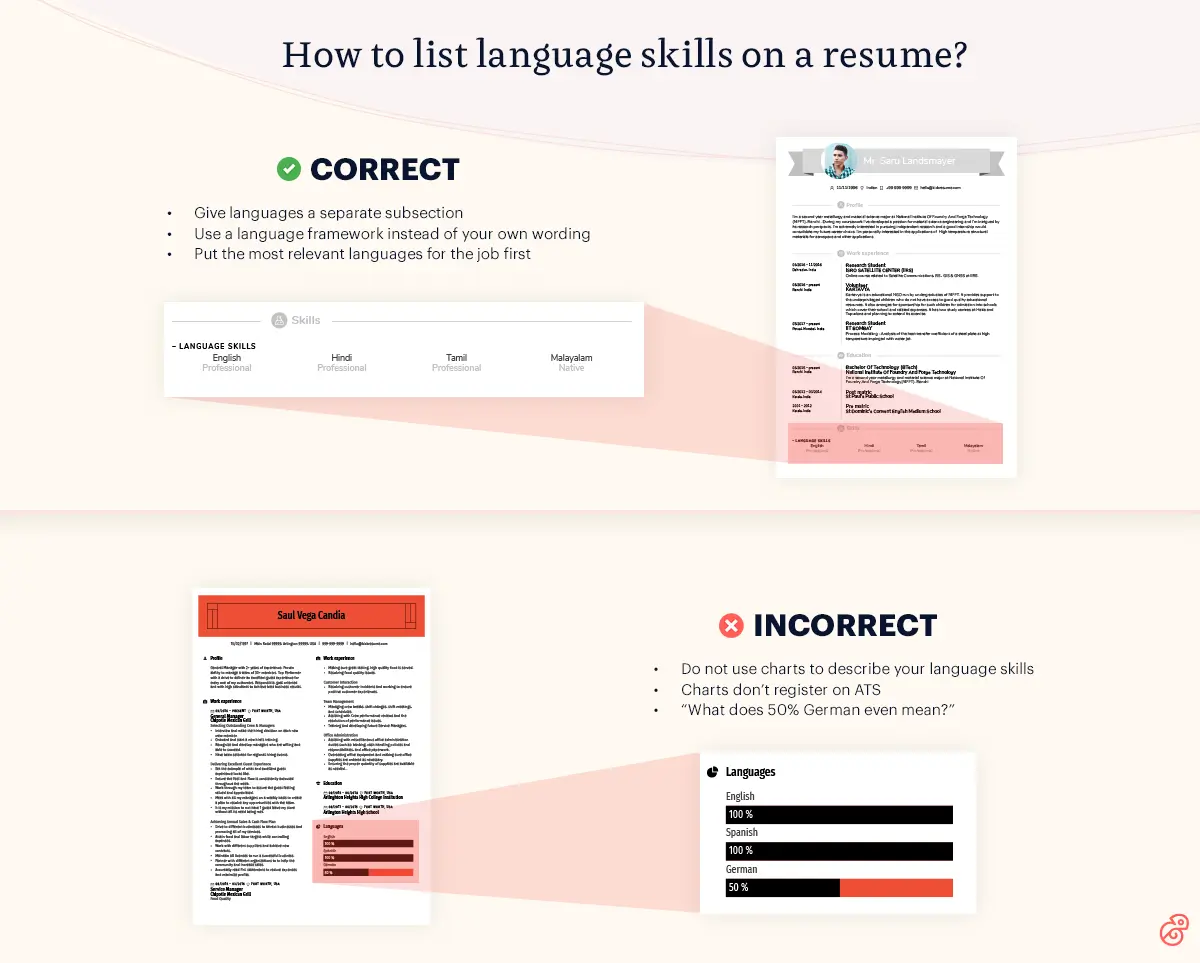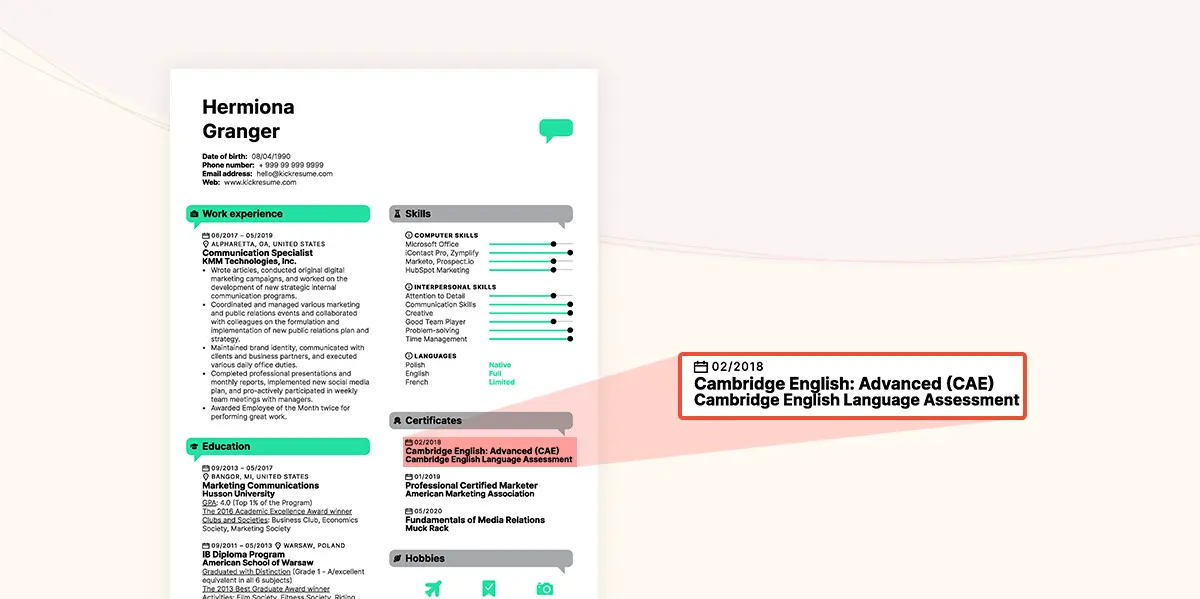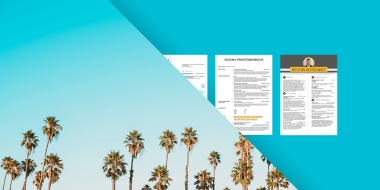Mastering a foreign language is one of the best things that can happen to you in life. That is, until you have to list these language skills on your resume.
Because what may seem like a straightforward issue at first can quickly become quite complicated.
In fact, it’s enough to make one’s head spin. In my case, it looked a bit like this:
“What are the levels of language proficiency? Wow! Why are there so many language proficiency scales? And what the heck is ACTFL, ILR and CEFR? Okay, obviously I can’t describe my language skills in words. I’m going to use a star rating instead! What do you mean that ATS can’t read it? I give up.”
Anyway, if you’re looking for a simple answer, you can find it in the next part of this article. Ultimately, you don’t have to understand every nerdy detail about language proficiency scales to produce a rock solid resume.
But if you’re willing to dig deeper, prepare for a really exhaustive answer that will explain all the abbreviations mentioned above! 🤓
How to list language skills on a resume
- Create a separate subsection for your language skills under your resume's skills section.
- Order them by relevancy. Start with the language that is most relevant for the job you want. Don't include any languages in which you're not proficient, or any languages that you're only beginning to learn.
- Follow a single language proficiency scale. List all languages using one of the language proficiency scales described below (CEFR, ILR, or ACTFL). Pick the one that a potential employer is most familiar with and stick to it.
- Use words, not charts. Use words to describe your levels of language proficiency, not charts or icons. This will help your resume get score more points with ATSs (applicant tracking systems that large companies use to scan candidates).
- Include certifications. If you took an exam and obtained a language certificate, include it in the certifications section of your resume. It gives a stronger backing
By following these simple steps you ensure that:
- the language skills on your resume don’t go unnoticed (they’ve got their own subsection)
- your strongest skill gets the attention it deserves (it sits at the top)
- and you don't confuse the employer by coming up with your own unfamiliar names for the levels of language proficiency.

What are the levels of language proficiency?
Welcome to the most confusing part of this article! Why confusing, you ask?
Because there are multiple language proficiency scales (of course there are). What’s more, each of them uses different letters and numbers to describe the same thing.
Fortunately, you only need to know about three of them: IRL, ACTFL, and CEFR.
Also, if all of this sounds intimidating, don’t worry too much. Remember, your main priority is to create a resume that clearly communicates your ability to use multiple languages professionally.
As long as you succeed in that, everything’s going to be all right, all right, all right.
Okay, then. Let’s take a look at those different levels of language fluency.

1. ILR (Interagency Language Roundtable)
The Interagency Language Roundtable scale is the standard grading scale for language proficiency developed by the United States’ federal-level service.
Because of that, it’s most commonly used in the USA, or more specifically, when applying for US government jobs.
And that’s probably everything that needs to be said about this scale. The rest you should be able to understand from the helpful comparison table above.
The ILR scale grades people’s language skills on a scale of 0–5 (5 being Native). In addition to that, it uses 0+, 1+, 2+, and 4+ to address those situations when a person’s language proficiency exceeds one skill level but doesn’t meet the criteria for the next level yet.
The ILR scale corresponds to the language levels used on LinkedIn.
2. ACTFL (American Council on the Teaching of Foreign Languages)
The ACTFL scale was developed from the ILR scale but it’s more granular with 11 grades of language proficiency instead of 6. According to the ACTFL website, it’s “intended to be used for global assessment in academic and workplace settings.”
Compared to the ILR, it can be a lot easier to understand even for people who couldn’t care less about language proficiency grades.
Which of the following is easier to decipher? “French: 4+ (ILR)” or “French: Advanced High (ACTFL)”.
3. CEFR (Common European Framework of Reference for Languages)
In Europe, we use the CEFR. This language proficiency scale is not derived from either of the American scales mentioned above, which is why it can be harder to convert grades from one into the other (that is officially).
This scale is universally understood in Europe and almost every European employer will know exactly what you mean by, for example, B2 Spanish.
4. LinkedIn language skills levels
LinkedIn uses the ILR language proficiency scale but instead of using numbers, they came up with their own wording for the individual ranks.
Because of that, you may want to determine your IRL language skill level before adding it to LinkedIn.
Which language proficiency scale should you use on your resume?
Always use the one that your future employer is most familiar with. But how do you know which one is it?
As usually, start with the job advertisement and look for the words they use to describe the required level of language proficiency.
Use the same words to describe your language skills in your resume (provided your skills are on that level).
How to correctly assess your level of language fluency?
If you don't know your exact language skills levels, don't guess.
Either you'll overestimate your abilities (which can lead to many uncomfortable situations in the future) or you'll underestimate yourself (which may sabotage your effort to show yourself in the best possible light on your resume).
What are your options then?
- Obtain an official language certificate. This often takes a lot of work and preparation but it can be worth it. It gives you a way to back your claims about your language skills levels and can make a stronger impression on the employer. On the other hand, sometimes it's simply an overkill. What's more, it can get pretty expensive, especially if you speak multiple languages and want to obtain an official certificate for each.
- Self-assess your language skill level. In most cases, self-assessment should suffice, as long as you don't try overestimate your abilities and follow official guidelines to grade yourself.
The official IRL website offers self assessment PDFs for speaking, reading, and listening.
The Council of Europe website provides official CEFR self assessment charts in most European languages.
The ACTFL website lets you download the complete text of the ACTFL Proficiency Guidelines. It's from 2012 but these things only get updated ever 10 years.
If you're looking for a less exhaustive version, this downloadable poster should give you all the information you need.

How to put bilingual on a resume?
What does it mean to be bilingual? By the most basic definition, a bilingual person is someone who speaks two languages.
But in order to be considered bilingual, you're usually expected to speak both languages really well in addition to having error-free grammar and perfect pronunciation.
Most people are able to achieve such level of language proficiency only by being born into linguistically mixed families or receiving formal education abroad.
Don't be afraid to describe your language skills as near native.
But there are also people who have been studying a second language for decades. Their command of language often surpasses that of many born speakers. What about them?
If that's your case, don't be afraid to describe your language skill as "near native". You won't be lying and it will help you get through various applicant tracking systems.
But don't just mention it in the language skills subsection of your resume. The competitive advantage of being bilingual is so big that you may want to mention it right at the beginning of your resume — in your resume summary (or resume objective) section.
Examples of language skills on resume
As they say, one example is often worth a thousand explanations!
Because of that, let me give you a couple of examples you can use as an inspiration for the language skills section on your own resume.
ILR language skills resume example 1
ILR language skills resume example 2 / LinkedIn language skills
ACTFL language skills resume example
CEFR language skills resume example
(Contrary to the previous ones, in the last example we didn't specify the language framework in parentheses. CEFR is so prevalent in Europe that you rarely have to do that.)
Pro at listing language skills on your resume now? Awesome! Boost your resume crafting skills even more and explore our professional resume samples.




